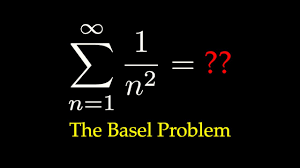Euler's Solution to the Basel Problem

Leonhard Euler, a renowned Swiss mathematician, solved the Basel problem in 1734. The Basel problem was one of the most famous and long-standing mathematical challenges of its time. It involved finding the exact value of the sum of the reciprocals of the squares of all positive integers.
The Basel problem can be formulated as follows:
Find the value of the series: 1 + 1/4 + 1/9 + 1/16 + 1/25 + ... + 1/n2 + . . .
Euler's approach to solving the Basel problem was ingenious and marked an essential contribution to the field of mathematics. Here's an overview of how Euler approached the problem:
1. Trigonometric Manipulation: Euler had previously worked extensively on trigonometric series and their relationships. He noticed a connection between trigonometric functions and the series in question.
2. Expanding Sine Function: Euler observed that the sine function could be expressed as an infinite polynomial:
sin(x) = x - (x3)/3! + (x5)/5! - (x7)/7! + . . .
3. Sine of Complex Numbers: Euler then explored the behavior of the sine function for complex numbers. He observed that when he set x = π, the expression became:
sin(π) = π - (π3/3! + (π5)/5! - (π7)/7! + . .
4. Equating Sine of Complex Number to 0: Euler knew that the sine of a multiple of π was always 0 (e.g., sin(0) = sin(π) = sin(2π) = . . .= 0). Therefore, he set the expression equal to 0:
sin(π) = 0
5. Simplifying the Equation: By simplifying the equation, Euler obtained:
π - (π3)/3! + (π5)/5! - (π7)/7! + . . . = 0
6. **Manipulating the Series**: Euler noticed that this equation resembled the series from the Basel problem, with alternating signs. To establish a connection, he multiplied both sides by π:
π2 - (π4)/3! + (π6)/5! - (π8/7! + . . . = 0
7. Comparing Coefficients: Euler then compared the coefficients of the powers of π on both sides of the equation. He realized that these coefficients were related to the terms in the series. In particular, he found that:
(π^2)/6 = 1 + 1/4 + 1/9 + 1/16 + . . .
8. Solving for the Sum: To find the sum of the series, Euler simply multiplied both sides by 6/π^2:
1 + 1/4 + 1/9 + 1/16 + . . . = (π2)/6
By this elegant and innovative approach, Euler was able to find the exact value of the sum of the reciprocals of the squares of all positive integers, resolving the Basel problem and making a significant contribution to the field of mathematics. The value (π2)/6 is now known as the Basel problem solution and has various applications in number theory and other areas of mathematics.